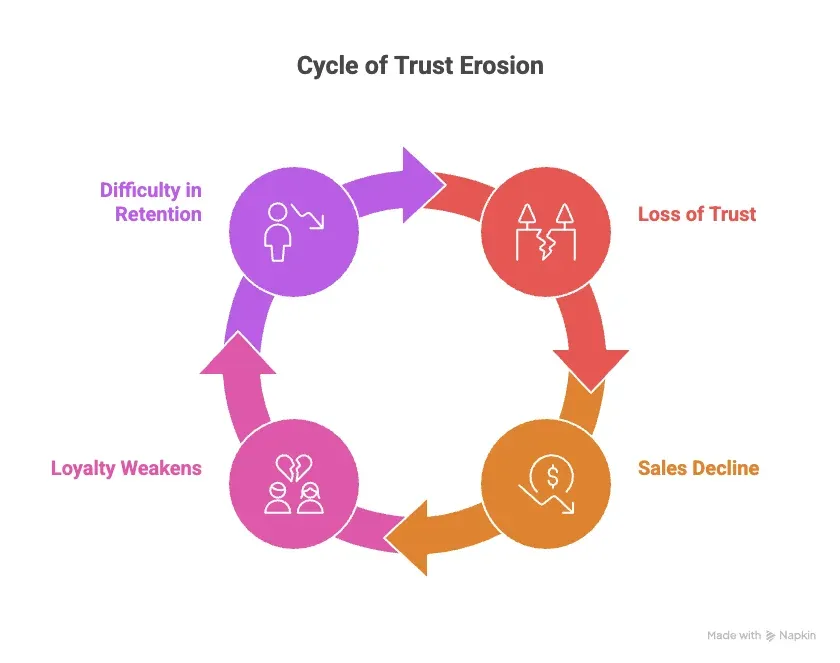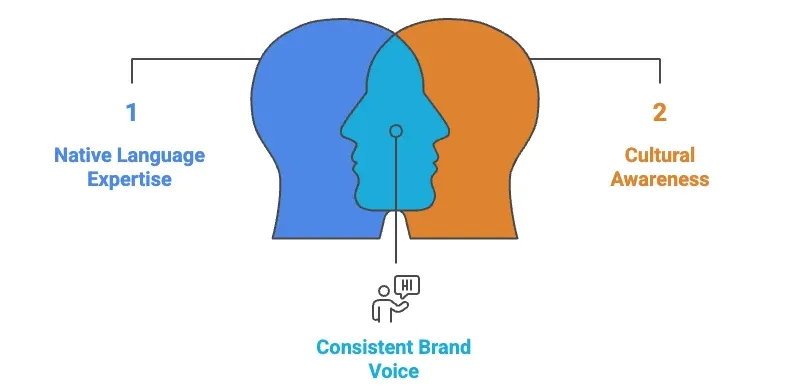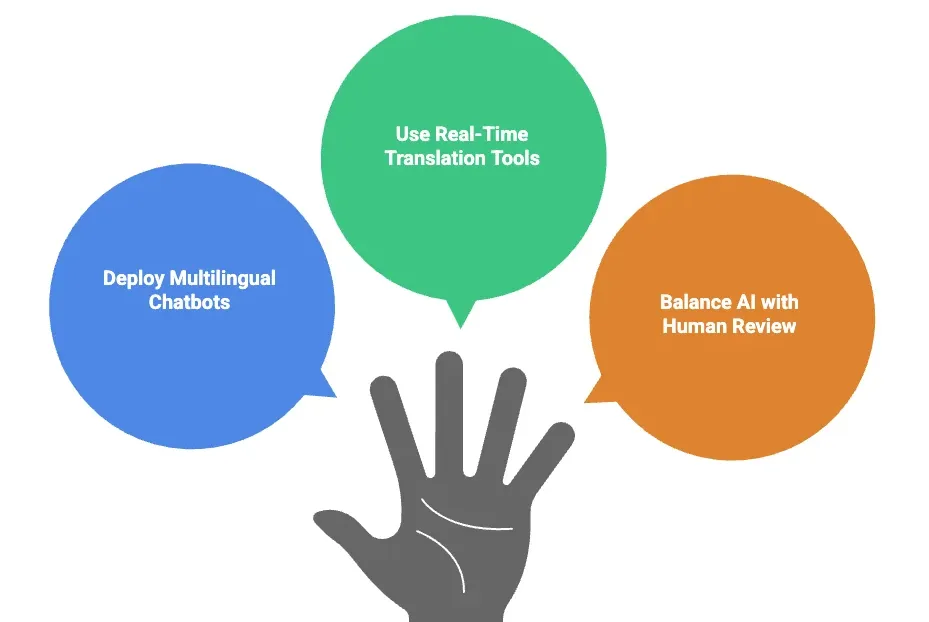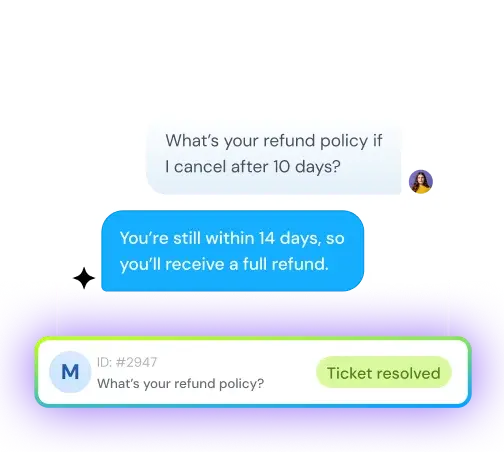Multilingual customer support: 4 proven strategies in 2025
Sneha Arunachalam
Oct 03, 2025

Imagine this: you’ve just bought a product, it’s not working as expected, and you need help—fast.
But when you reach out, the support team doesn’t speak your language. Frustrating, right? You’re not alone. With over 350 languages spoken in the U.S. alone, this scenario happens far more often than most businesses realize.
Here’s the kicker: 76% of customers prefer buying products with information in their own language. That’s not just a preference—it’s a clear vote with their wallets. And it gets bigger. More than 21% of U.S. households speak a language other than English at home, and globally, 7 out of 10 consumers expect brands to deliver experiences in their native language.
The takeaway? There’s a huge opportunity for businesses willing to speak their customers’ language—literally.
In this blog, we’ll walk you through four proven strategies to connect with customers worldwide, boost loyalty, and unlock new markets. Whether you’re just starting your multilingual customer support journey or looking to level up, these approaches could be the difference between losing customers to language barriers and turning them into your most loyal advocates.
Why speaking your customers' language actually matters
Every time someone contacts your support team, language becomes either your best friend or your worst enemy. It's that simple.
Language as a bridge or barrier
When customers can explain their problems in their own language, everything just flows better. They're more relaxed, more detailed about their issues, and way more satisfied with your service. But flip that around, and language barriers become relationship killers.
Here's what happens: a customer struggles to describe their problem because of language limitations. Your team can't quite grasp what's wrong. The issue goes unresolved, and suddenly your service looks terrible — even though the real problem was just communication.
When communication breaks down, the damage goes deeper than one bad interaction:

- Customer trust takes a hit
- Sales suffer
- Long-term loyalty weakens
But here's the flip side: when customers feel truly understood, they become your biggest advocates. They'll stick around longer, buy more, and even pay premium prices for products backed by excellent service in their language.
Customer expectations have completely shifted
The rules of customer service changed while many businesses weren't paying attention. What used to be a nice bonus — support in multiple languages — is now something customers expect from any serious brand.
A Zendesk study found that 70% of global consumers consider native language support essential, not optional. That word "essential" should get your attention — customers aren't just asking nicely anymore.
Modern customers want more than your product or service. They want to feel valued through experiences that respect who they are and how they communicate. This expectation crosses every industry and market you can think of.
That gap between what customers want and what businesses provide? That's your opportunity.
The bottom line: multilingual support isn't a luxury anymore — it's table stakes. Companies that get this will pull ahead in customer satisfaction, loyalty, and market share. Those that don't will keep wondering why their customers are disappearing.
What multilingual customer support actually does for Your Business
Think of it like this: every customer interaction in their native language is money in the bank. We're not talking about feel-good metrics here — this stuff directly impacts your bottom line in ways you can measure.
Customers who actually stick around
When someone can express their problem in their own language, everything changes. No more playing charades with Google Translate. No more frustrated customers hanging up because they can't explain what's wrong.
The satisfaction boost is real. CSA Research found that customer satisfaction rates "skyrocket" when support services are offered in the user's language. Problems get solved faster. Fewer misunderstandings. Less back-and-forth trying to figure out what's actually broken.
Here's the thing — when customers feel understood, they relax. That comfort translates directly into smoother problem resolution and prevents the kind of frustration that sends people straight to your competitors.
Markets you didn't know you could reach
Sticking to one language? You're basically putting a cap on your potential customer base. Multilingual customer support opens doors to segments you couldn't touch before.
The revenue impact is serious: businesses engaging non-English speaking customers can boost revenue by up to 30%. Companies with strong multilingual strategies were 1.5 times more likely to report revenue growth.
Linguistic diversity helps businesses break into new customer segments even in crowded, competitive markets. When potential customers can't communicate in their native language, they often just walk away and never come back.
Standing out when most won't
Less than half of all brands currently offer multilingual customer support. That gap? It's your competitive advantage.
Your investment in multiple languages shows customers you actually care about reaching them on their terms. Companies providing multilingual service get seen as more inclusive and welcoming — the kind of reputation that drives word-of-mouth marketing and attracts new customers.
Bottom line: multilingual support does more than solve immediate problems. It positions your business as one that values diversity and genuinely wants to serve all customers — not just the ones who happen to speak English.
Strategy 1: Build your multilingual customer support dream team

Getting multilingual support right starts with one simple truth — your customers can tell the difference between someone who truly speaks their language and someone just getting by with translation apps.
Find native speakers who get it
Here's the thing about native speakers: they don't just know the words, they know the feeling behind them. When a customer says they're "gutted" about a delayed order, a British agent immediately understands that's way more than just "disappointed." That kind of nuance? You can't teach it.
Native speakers bring stuff you literally can't get anywhere else:
- Problems get solved faster because there's no mental translation happening
- Conversations feel natural, especially when things get tense
- Cultural references actually make sense instead of causing confusion
- Complex issues don't get lost in translation
The research backs this up too — Japanese customers want to talk to agents from Japan, Scottish customers prefer fellow Scots. It's not just about language, it's about connection.
Sure, non-native speakers can do the job. But when it comes to customer service, there's really no substitute for someone who grew up with the language. They can read between the lines, catch the emotional undertones, and respond in ways that feel genuinely human.
Teach cultural awareness (because words aren't everything)
Knowing the language is just step one. Cultural missteps can torpedo even perfect grammar.
Think of it like this: calling a German customer by their first name might come across as disrespectful, while being too formal with an American customer feels stuffy and weird. Same language family, totally different expectations.
Your cultural training should cover the basics:
- How formal or casual to be in different situations
- What topics are off-limits or sensitive
- How directness is perceived (Germans appreciate it, others might find it rude)
Studies show that cultural sensitivity training isn't optional anymore — it prevents misunderstandings and builds the kind of trust that keeps customers coming back.
Keep your brand voice consistent across languages
This is where things get tricky. Your brand needs to sound like you whether someone's chatting in English, Spanish, or Mandarin.
The solution? Create templates and scripts that capture your brand personality while allowing for cultural adaptation. Maybe your English support is casual and friendly — that might translate to slightly more formal but still warm in Japanese, or more expressive in Italian.
Don't just assume anyone bilingual can handle translation work. Professional language services bring the expertise to keep your tone consistent across languages — something that's nearly impossible to nail without proper training and quality checks.
Set up a central knowledge base where all your multilingual resources live. That way, whether someone's handling a ticket in Portuguese or Polish, they've got the right tools to sound authentically like your brand.
When you nail the hiring, training, and consistency pieces, your multilingual team becomes more than just support agents — they become cultural ambassadors who create genuine connections with customers around the world.
Strategy 2: Use AI and automation for language support

Think of it like this: AI isn't going to replace your human support team, but it can handle the heavy lifting while your agents focus on what really matters. These tools have gotten pretty impressive at bridging language gaps — and they never need a coffee break.
Deploy multilingual chatbots
Your chatbot can be that helpful first point of contact customers need, no matter what language they speak. Here's what modern AI chatbots bring to the table:
- Round-the-clock availability across every time zone
- Instant responses in customers' preferred languages
- Smart enough to handle routine questions without missing a beat
- Frees up your human agents for the complex stuff that really needs that personal touch
We're not talking about those clunky chatbots from a few years ago. Today's AI actually gets context and intent across languages, making conversations feel way more natural. That's pretty amazing when you think about it — your small support team can suddenly serve customers worldwide.
Use real-time translation tools
Real-time translation has come a long way from those awkward, robotic translations we used to get. Current tools can instantly translate text and speech across hundreds of language pairs while keeping the meaning intact.
Here's what they can do now: instantly identify a customer's language and intent when they reach out, provide two-way translation for both text and voice, and even convert speech to text, translate it, and convert it back to speech for seamless phone calls.
You can plug these tools into pretty much everything — your ticketing system, live chat, email support, even social media channels. Many support platforms now include AI translation built right in, so no need for expensive third-party solutions.
The real game-changer? You can translate your entire knowledge base and help center content. Customers get self-service in their own language, which cuts down your support tickets while making everyone happier.
Balance AI with human review
AI translation has made huge strides, but it's not perfect. The sweet spot is using both AI speed and human insight together.
Here's what works: let AI handle the initial conversations and routine stuff for instant responses across languages. Have human agents review and polish AI-generated content, especially for important materials. When things get complex or sensitive, make sure there's a smooth handoff to human agents.
This approach lets you scale without sacrificing quality. As one expert puts it, "AI is not the enemy of human interpreters. It is a tool that, when used correctly, supports them".
At minimum, have native speakers review your AI-translated knowledge base and help articles. They'll catch those cultural nuances and context clues that machines still miss, making sure your support feels authentic instead of robotic.
The future isn't about choosing AI or humans — it's about using both together. AI gives you speed and scale, humans bring depth and understanding. Combine them right, and you've got a support system that's both efficient and genuinely helpful for customers around the world.
Strategy 3: Build a multilingual help desk and knowledge base
Think of it like this: your help center is like a 24/7 librarian that never sleeps. When customers can find answers in their own language, they don't need to wait for support — they solve problems themselves. Over 60% of US customers actually prefer this approach for simple tasks.
Translate FAQs and help articles
Here's what most businesses get wrong — they think any translation will do. Professional translators who are native speakers catch cultural nuances that machine translation completely misses. That attention to detail keeps your content clear and culturally appropriate across languages.
When you're building out your multilingual knowledge base:
- Focus your budget on high-traffic articles first — that's where you'll see the biggest return
- Write your original content with translation in mind, using plain language and skipping the idioms
- Keep formatting consistent across every language version
- Make sure your FAQs match how people actually search in each language for better SEO
The investment pays off by preventing those costly misunderstandings that can wreck customer relationships.
Use localized content examples
Word-for-word translation misses the mark. Your content needs to feel like it was written specifically for each market. That means swapping out examples, adjusting currency formats, and using references that actually make sense locally.
Here's what smart companies do when creating help articles for different regions:
- Replace US-centric examples with local scenarios that resonate
- Update screenshots to show localized interfaces
- Use the terminology and product names people actually recognize
When customers see content that speaks to their specific situation, engagement and loyalty shoot up. Plus, it removes those language and cultural barriers that might otherwise stop someone from buying.
Enable self-service in multiple languages
A solid multilingual knowledge base lets customers help themselves around the clock, cutting your support tickets while boosting satisfaction. That 24/7 availability becomes crucial when you're supporting customers across different time zones.
Here's how to maximize your multilingual self-service impact:
Start by tracking which languages your customers request most. Set up AI-powered chatbots that detect visitor location and offer language options automatically. Keep your translated content fresh by updating it based on customer feedback.
For growing businesses, multilingual self-service creates the foundation for scaling. Even without round-the-clock human support in every language, customers can still find answers. As you expand into specific regions, you can decide whether to add dedicated human support or stick with your AI-first approach.
The bottom line? Localizing your help center isn't optional anymore — it's what customers expect. When you offer self-service in multiple languages, you're removing barriers, building stronger relationships, and creating a more inclusive experience for everyone.
Strategy 4: Meet customers where they actually want to talk
Customer preferences aren't one-size-fits-all — and that's especially true when it comes to how people want to get help. American customers might pick up the phone, Japanese customers prefer figuring things out themselves, and Brazilian customers? They're all over social media and WhatsApp.
Think of it like this: offering the same support channels everywhere is like opening the same restaurant in Tokyo, São Paulo, and Detroit without changing the menu. You'll miss what people actually want.
Get social with multilingual customer support
Social media isn't just where people share vacation photos anymore — it's become a major customer service channel. Here's what works:
- Set up language-specific accounts for your biggest markets
- Staff them with native speakers who get the cultural nuances
- Use real-time translation for comments and messages
- Create content calendars that make sense for each region
Plenty of businesses now offer multilingual support across X, Facebook, and Instagram, letting customers reach out in whatever language feels natural. This approach really clicks with younger customers — Gen Z and millennials actually prefer sliding into DMs when they need help.
14-day free trial • Cancel Anytime • No Credit Card Required • No Strings Attached
Make live chat and email work in any language
Live chat has become the go-to for instant help across language barriers. The smart platforms can detect what language someone's using and route them to the right agent or translation service. Speed matters here — when companies respond within 5-10 seconds via chat, satisfaction rates spike
For email support, create templates in multiple languages so your messaging stays consistent. Email lets customers explain complex problems thoroughly in their preferred language, which is perfect for technical issues. Pair that with AI translation tools, and you can deliver personalized responses across languages.
Don't forget about phone support
Even with all the digital options, some problems still need a real conversation. Interactive voice response systems can direct customers to agents who speak their language.
Time zones get tricky when you're supporting global customers. Different countries switch their clocks on different schedules, which affects when people expect support. That's why many companies partner with local support providers who understand regional customs and regulations.
Remember — cultural differences go way deeper than language. Arabic speakers in Morocco communicate differently than those in Lebanon, making locally-based support crucial for building genuine connections.
Here's the thing about language barriers
Multilingual customer support isn't just nice anymore — it's what separates businesses that grow from those that get left behind.
These four strategies work best together, not in isolation. Your native-speaking agents create those authentic human moments that build trust. AI tools let you scale without breaking the bank. Self-service in multiple languages gives customers answers when they need them, not when you're available. And meeting customers where they actually want to talk? That's just smart business.
The results are pretty clear. Better satisfaction, stronger loyalty, bigger markets, better reputation — all the stuff that actually moves the needle on your bottom line.
But here's what most businesses miss: this isn't a "set it and forget it" kind of thing. Customer preferences shift as markets change, so you'll need to keep tabs on which languages matter most to your growth. Start with the languages your best customers speak, then expand as opportunities show up.
Think of multilingual customer support like this: if you're serious about competing globally, language barriers can't be your customers' problem to solve. Make it easy for them to get help in their language, and they'll make it easy for you to keep their business.
Actionable multilingual support tips at a glance
What to Do | How to Do It | Why It Matters |
Hire native agents | Recruit staff fluent in the customer’s language. | Conversations feel natural, problems get solved faster. |
Train for culture | Teach agents local customs & communication styles. | Builds trust and prevents misunderstandings. |
Keep brand voice consistent | Use professional translations & scripts. | Customers experience a unified brand, no matter the language. |
Use AI chatbots | Provide 24/7 automated support in multiple languages. | Instant answers, reduced workload, happier customers. |
Leverage real-time translation | Translate chats, emails, and calls instantly. | Removes language barriers and speeds up resolution. |
Create multilingual help center | Translate FAQs, guides, and self-service articles. | Customers find answers themselves, lowering support tickets. |
Localize content examples | Adjust references, screenshots, and terminology per region. | Content resonates better, increasing engagement & loyalty. |
Support customers on their channels | Offer help via chat, email, social media, or phone in local languages. | Meets customers where they are, improving satisfaction. |
Confirm & follow up | Verify understanding and share localized docs if needed. | Reduces confusion and ensures problems are fully solved. |
To go deeper, read our detailed breakdown on why multilingual live chat is essential for businesses in 2025 and learn how it boosts loyalty and conversions.
Multilingual customer support: 4 essential strategies
Multilingual customer support has become essential for businesses looking to build strong customer relationships and expand globally. Speaking your customers' language directly impacts satisfaction, loyalty, and market reach.
- Build a native-speaking team - Hire agents who understand cultural nuances, provide cultural sensitivity training, and maintain consistent brand voice across all languages
- Deploy AI and automation - Use multilingual chatbots for round-the-clock support, implement real-time translation tools, and balance automation with human review for quality
- Create multilingual self-service - Translate FAQs and help articles professionally, localize content with region-specific examples, and enable customers to find answers independently
- Meet customers on their channels - Offer support via social media, live chat, email, and phone in customers' preferred languages based on regional preferences
Companies that invest in multilingual support see higher satisfaction, stronger loyalty, and access to new markets—turning language from a barrier into a competitive advantage.
Frequently Asked Questions
Multilingual customer support refers to the ability of a business to provide customer service in multiple languages, allowing customers to communicate in the language they are most comfortable with.
In practice, this means:
- Support channels in multiple languages
- Customers can reach out via email, chat, phone, or social media in their native language.
- Native or fluent agents
- Support agents are proficient in the target languages, ensuring clear, natural, and culturally sensitive communication.
- Localized resources
- FAQs, knowledge bases, and help articles are translated and adapted for each language and culture.
- AI & translation tools
- AI chatbots or translation software can provide instant support in multiple languages, often combined with human review for accuracy.
Why it matters:
- It improves customer satisfaction, loyalty, and retention.
- It expands your reach to global markets.
- It reduces miscommunication and resolves issues faster.
In short, multilingual customer support isn’t just translation — it’s about delivering a seamless, culturally aware customer experience across languages.
Businesses can offer multilingual support by hiring fluent or native-speaking agents, translating help articles and FAQs, using AI-powered chatbots for real-time translations, and localizing content for cultural context.
Begin by identifying the languages most commonly used by your customers, hire or train agents fluent in those languages, translate critical support resources, and consider AI tools for scalable, real-time communication.
- Stay Calm and Respectful – Be patient and maintain a friendly tone.
- Identify Their Language – Ask politely or let them select their preferred language.
- Use Translation Tools – Leverage live chat translation or multilingual support platforms.
- Route to Fluent Staff – If available, connect them with an agent who speaks their language.
- Simplify Communication – Use short, clear sentences and avoid jargon.
- Confirm Understanding – Ask if they understood the instructions or solution.
- Follow Up – Send documentation or links in their language when possible.
Tip: Even partial understanding combined with patience and helpful tools creates a positive experience.
Yes. By removing language barriers, businesses can expand into new markets, improve customer trust, and increase repeat purchases, ultimately boosting revenue and market share.
